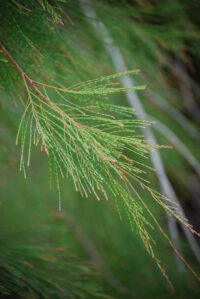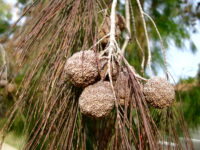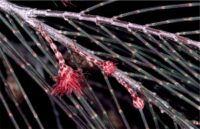Allocasuarina torulosa, commonly known as the Forest Oak or Rose She-oak, is a species of flowering tree in the family Casuarinaceae.
It is endemic to eastern Australia and is notable for its distinctive foliage, bark, and ecological roles.
Taxonomy:
- Family: Casuarinaceae
- Genus: Allocasuarina
Description:
- Growth: Reaches a height of 10 to 25 meters, although some specimens can grow taller in optimal conditions. Spread is usually around 5 to 10 meters, giving it a relatively narrow, columnar form.
- Leaves and Branchlets: Does not have traditional leaves; instead, it possesses green, photosynthetic branchlets with minute scale-like leaves arranged in whorls around the branchlets these resemble pine needles and are segmented, which gives the tree a feathery appearance.
- Bark: Rough and furrowed, typically dark grey or brown. It provides a striking contrast to the fine texture of the branchlets.
- Cones: This species is dioecious, meaning individual trees are either male or female. Male trees produce small, brownish flower spikes. While female trees produce small, globular cones that are woody and contain numerous seeds. The cones are a distinguishing feature of the species and have a unique, spiky appearance.
Habitat and Distribution:
Found in coastal and sub-coastal regions of eastern Australia, ranging from northern New South Wales to southern Queensland. Thriving well-drained soils and can often be found in sclerophyll forests, woodlands, and occasionally in rainforest margins.
Hosts: (included but not limited to)
- Eastern Rosella (Platycercus eximius): They play a role in seed dispersal by consuming seeds and potentially transporting them short distances before excreting them.
- Common Bronzewing (Phaps chalcoptera): This medium-sized pigeon species is found in Allocasuarina torulosa habitats. Where it feeds on a variety of seeds, including those of Forest Oaks.
- Glossy Black Cockatoo (Calyptorhynchus lathami): Have a specialized diet that primarily includes the seeds of Allocasuarina species. They are particularly adapted to feed on the seeds found within the cones.
- Yellow-tailed Black Cockatoo (Calyptorhynchus funereus): Adapted to accessing and opening the woody cones of Forest Oaks to consume the seeds inside. Their strong bills and dexterous claws enable them to manipulate the tough cones effectively.
Ecology and Uses:
- Nitrogen Fixation: Forms symbiotic relationships with nitrogen-fixing bacteria (Frankia) in its root nodules. This ability to fix atmospheric nitrogen enriches the soil, making it an important species for maintaining soil fertility in its native habitats.
- Timber: The wood is hard and durable, making it valuable for furniture, flooring, and fencing. It’s fine grain and attractive color, often with a reddish hue, make it a sought-after material for decorative woodworking.
- Ornamental: Due to its aesthetic appeal, it is used as an ornamental tree in landscaping. Appreciated for its unique foliage and overall form.




